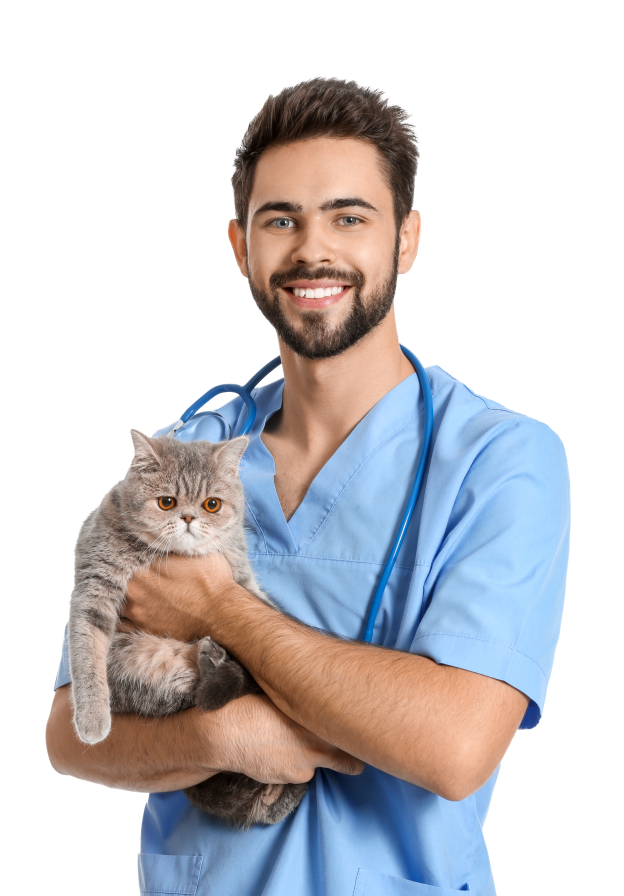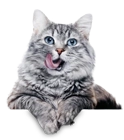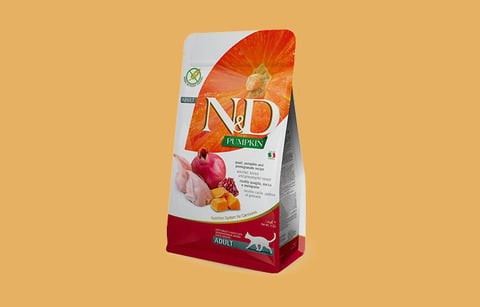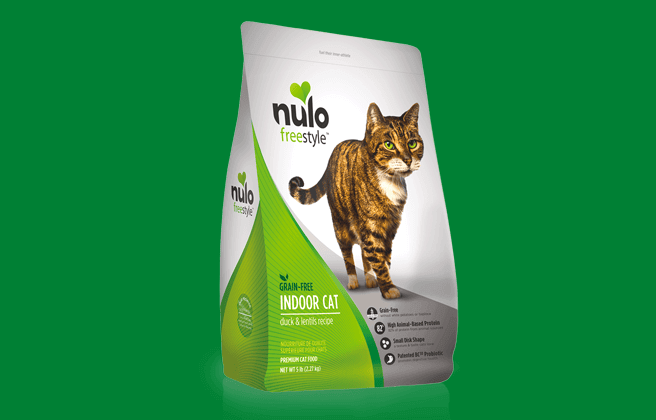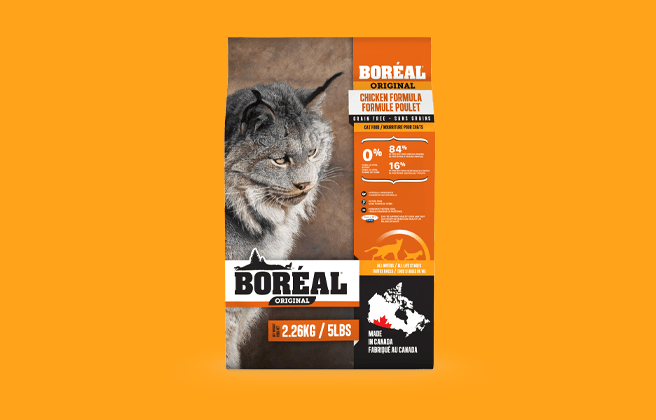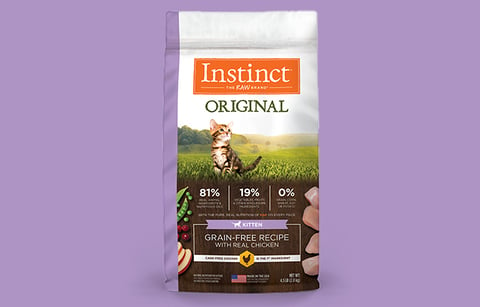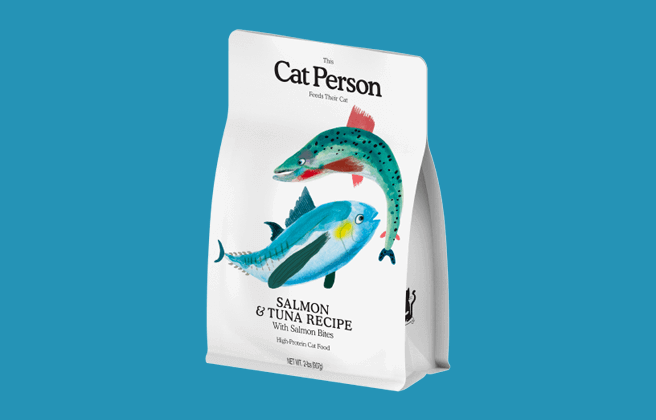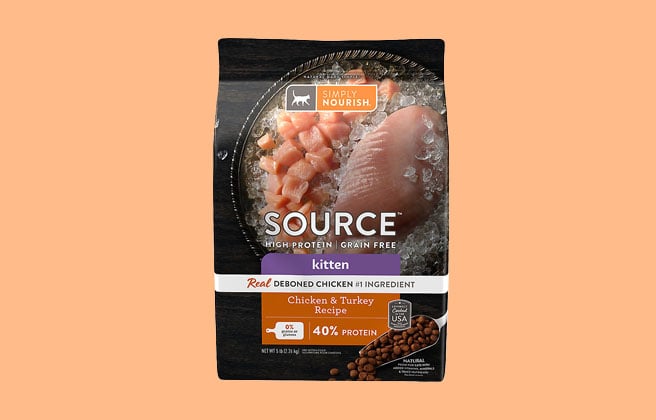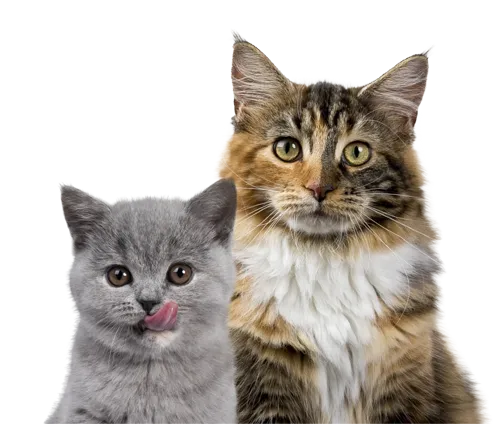
Our Verdict
Royal Canin Veterinary Diet dry cat food is made up of seven recipes which are not rated due to their intentional therapeutic design.
This range of tailored nutritious formulas is designed by veterinarians to tackle particular feline conditions, while supporting overall health and wellbeing.
Pros
- Formulas are designed by veterinary professionals
- Recipes target specific sensitivities in felines
- Added vitamins and minerals
Cons
- Contains meat bi-products
- High carbohydrate content
- More expensive than some cat foods
The table below shows each recipe in the range . Royal Canin is not formulated to meet AAFCO nutrient profiles. It is formulated to be complete and balanced for adult cats, meeting the FEDIAF nutrient guidelines. FEDIAF is the equivalent to AAFCO within Europe.
| Product line | Rating | AAFCO |
|---|---|---|
| Royal Canin Veterinary Diet Adult Gastrointestinal Fiber Response Dry Cat Food | Unrated | U |
| Royal Canin Veterinary Diet Adult Hydrolyzed Protein Dry Cat Food | Unrated | U |
| Royal Canin Veterinary Diet Adult Urinary SO Moderate Calorie Dry Cat Food | Unrated | U |
| Royal Canin Veterinary Diet Adult Satiety Support Weight Management Dry Cat Food | Unrated | U |
| Royal Canin Veterinary Diet Adult Renal Support S Dry Cat Food | Unrated | U |
| Royal Canin Veterinary Diet Adult Calm Dry Cat Food | Unrated | U |
| Royal Canin Veterinary Diet Adult Glycobalance Dry Cat Food | Unrated | U |
Save up to 35%
with Autoship
See discount in cart
Recipe and Label Analysis
Royal Canin Veterinary Diet Adult Hydrolyzed Protein Dry Cat Food recipe was selected to represent the other products in the line for a detailed recipe and nutrient analysis.
Label and nutrient data below are calculated using dry matter basis.
Royal Canin Veterinary Diet Adult Hydrolyzed Protein Dry Cat Food recipe
Estimated Dry Matter Nutrient Content
Protein
Fat
CarbsCarbohydrates
Brewers rice, hydrolyzed soy protein, chicken fat, powdered cellulose, natural flavors, dried plain beet pulp, calcium sulfate, fish oil, potassium chloride, vegetable oil, dl-methionine, monocalcium phosphate, sodium pyrophosphate, salt, sodium aluminosilicate, fructooligosaccharides, calcium carbonate, choline chloride, vitamins[dl-alpha tocopherol acetate (source of vitamin E), niacin supplement, l-ascorbyl-2-polyphosphate (source of vitamin C), d-calcium pantothenate, biotin, pyridoxine hydrochloride (vitamin B6), riboflavin supplement, thiamine mononitrate (vitamin B1), vitamin A acetate, vitamin B12 supplement, folic acid, vitamin D3 supplement], taurine, gla safflower oil, marigold extract (tagetes erecta l.), trace minerals[zinc proteinate, zinc oxide, manganese proteinate, manganous oxide, copper sulfate, ferrous sulfate, sodium selenite, copper proteinate, calcium iodate], magnesium oxide, rosemary extract, preserved with mixed tocopherols and citric acid.
Fiber (estimated dry matter content) = 5.7%
Red denotes any controversial items
Ingredients Analysis
The first ingredient is brewer’s rice. Brewers rice is a cereal grain by-product consisting of the small fragments left over after milling whole rice. Aside from the caloric energy it contains, this item is of only modest nutritional value to a cat.
The second ingredient is hydrolyzed soy protein. Soy protein isolate is a highly refined form of soy bean protein with a protein content of about 90%.
In this case, the soy protein has been hydrolyzed which means it has been broken down into its individual amino acid components.
Hydrolyzed protein is valued by veterinary professionals because of its proven and effective properties.
The third ingredient is chicken fat. Chicken fat is obtained from rendering chicken, a process similar to making soup in which the fat itself is skimmed from the surface of the liquid.
Chicken fat is high in linoleic acid, an omega-6 fatty acid essential for life. Although it doesn’t sound very appetizing, chicken fat is actually a quality ingredient.
The fourth ingredient is powdered cellulose, an insoluble plant fiber usually made from the by-products of vegetable processing. As a fiber isolate cellulose can convey a number of functional benefits in the diet, from reducing the energy density and promoting satiety in a weight control diet, to supporting digestion and dental health.
The fifth ingredient is natural flavors, which doesn’t give us much information about the particular ingredients included in this cat food for flavoring purposes.
We’re pleased that the flavorings used are natural, but more details are required to give any further information about these natural flavoring ingredients. Flavorings are used to make the foods more appealing and tasty for our cats.
The sixth ingredient is dried plain beet pulp. Beet pulp is a controversial ingredient, a high fiber by-product of sugar beet processing.
Some denounce beet pulp as an inexpensive filler while others cite its outstanding intestinal health and blood sugar benefits.
We only call your attention here to the controversy and believe the inclusion of beet pulp in reasonable amounts in most cat foods is entirely acceptable.
The seventh ingredient is calcium sulfate, a source of supplemental calcium.
The eighth ingredient is fish oil. Fish oil is naturally rich in the prized EPA and DHA type of omega-3 fatty acids. These two high quality fats boast the highest bio-availability to cats and humans.
Depending on its level of freshness and purity, fish oil should be considered a commendable addition.
From here the list goes on to include a number of other items. But to be realistic, ingredients located this far down the list (other than nutritional supplements) are not likely to affect the overall rating of the product.
Save up to 35%
with Autoship
See discount in cart
Nutrient Analysis
Based on its ingredients alone, Royal Canin Veterinary Diet Adult Hydrolyzed Protein Dry Cat Food looks like an average dry product.
The dashboard displays a dry matter protein reading of 26.1%, a fat level of 19.6% and an estimated carbohydrate level of 46.3%.
As a group, the brand features a below-average protein content of 34.2% and a mean fat level of 13.6%. Together these figures suggest a carbohydrate content of 44.2% for the overall product line, alongside a fat to protein ratio of 44%.
This means this Royal Canin Veterinary Diet dry range contains lower than average protein, higher than average carbohydrate and near-average fat, when compared to typical dry cat food.
Final Word
This food gives you tailored, nutritional recipes to support and manage your cat’s specific health condition – whether it’s kidney disease or weight management.
However, although designed by veterinarians, our review has nothing to do with the accuracy of claims made by the manufacturer as to the product’s ability to treat a specific health condition.
To find out whether or not this product is appropriate for your particular pet, it’s important to consult your veterinarian.
Has Royal Canin cat food been recalled in the past?
Yes, Royal Canin has been recalled four times over the past 15 years.
January 2023.
Cause: Product is mislabeled and some bags may contain a different product.
What was recalled: Royal Canin Veterinary Feline Renal Support F dry cat food in 6.6 lb (3 kg) bags. For full details read see our recall page.
May 2007.
Cause: Melamine.
What was recalled: The following Royal Canin dry pet foods with date codes between July 28, 2007 and April 30, 2008:
Sensible Choice Chicken and Rice Adult dry dog food, Sensible Choice Chicken and Rice Reduced dry dog food, Sensible Choice Lamb and Rice Reduced dry dog food, Sensible Choice Chicken and Rice Puppy dry dog food, Sensible Choice Chicken and Rice Large Breed Puppy dry dog food, Sensible Choice Natural Blend Adult dry dog food, Sensible Choice Natural Blend Senior dry dog food, Sensible Choice Natural Blend Puppy dry dog food, Kasco Chunks dry dog food, Kasco Hi Energy dry dog food, Kasco Maintenance dry dog food, Kasco Mealettes dry dog food, Kasco Mini Chunks dry dog food, Kasco Puppy dry dog food, Kasco Cat dry cat food.
April 2007
Cause: Melamine.
What was recalled: The following Royal Canin dry pet foods: Royal Canin Veterinary Diet Canine Early Cardiac EC 22 dry dog food, Royal Canin Veterinary Diet Canine Skin Support SS21 dry dog food, Royal Canin Veterinary Diet Feline Hypoallergenic HP23 dry cat food, Sensible Choice Chicken Meal & Rice Formula Senior dry dog food, Sensible Choice Lamb Meal & Rice Formula Puppy dry dog food, Sensible Choice Lamb Meal & Rice Formula Adult dry dog food, Sensible Choice Lamb Meal & Rice Formula Senior dry dog food, Sensible Choice Rice & Catfish Meal Formula Adult dry dog food.
February 2006
Cause: Too much Vitamin D3.
What was recalled: The following Royal Canin pet foods: Royal Canin Veterinary Diet Canine Urinary SO dog food, 13.6 oz. cans, Codes 511A/B and 521 A/B, best by March 2007, Royal Canin Veterinary Diet Canine Urinary SO dog food, 13.6 oz. cans, Code 525A, best by June 2007, Royal Canin Veterinary Diet Canine Low Fat LF dog food, 13.6 oz. cans, Code 526A/B, best by June 2007, Royal Canin Veterinary Diet Canine Calorie Control CC in Gel dog food, 12.7 oz. cans, Code 515B, best by April 2007, Royal Canin Veterinary Diet Canine Calorie Control CC in Gel dog food, 12.7 oz. cans, Code 528A, best by July 2007, Royal Canin Veterinary Diet Feline Sensitivity VR cat food, 5.8 oz. cans, Code 518A, best by May 2007, Royal Canin Veterinary Diet Feline Calorie Control CC cat food, 5.8 oz. cans, Code 449A, best by November 2006, Royal Canin Veterinary Diet Feline Calorie Control CC cat food, 5.8 oz. cans, Code 451A, best by December 2006, Royal Canin Veterinary Diet Feline Calorie Control CC cat food, 5.8 oz. cans, Code 515A, best by April 2007, Royal Canin Veterinary Diet Feline Renal LP cat food, 3 oz. pouches, Codes 519B and 522B, best by September 2006, Royal Canin Veterinary Diet Feline Renal LP cat food, 3 oz. pouches, Code 526A, best by October 2006, Royal Canin Veterinary Diet Feline Renal LP cat food, 3 oz. pouches, Codes 541A and 543A, best by February 2007.
You can view a complete list of all cat food recalls since 2021 here.
To stay on top of any cat food product recalls, sign up for our free email alerts, here.
About
Royal Canin was started back in the 1960s by veterinary surgeon Jean Cathary who lived in France.
The worldwide headquarters is in Southern France, and U.S. products are manufactured in company-owned plants in Missouri, South Dakota and Canada.
Sources
Best cat foods
We uphold the highest editorial standards when creating the authoritative content pet parents rely on and trust.
Every piece of clinical content on the Cat Food Advisor is reviewed by our certified Veterinary Advisory Board, which consists of licensed veterinarians and medically certified specialists.
Our reviews are completely independent; we are not paid by any pet food company to promote their products favorably. We do not accept money, gifts, samples or other incentives in exchange for special consideration. For more information see our Disclaimer & Disclosure page.
